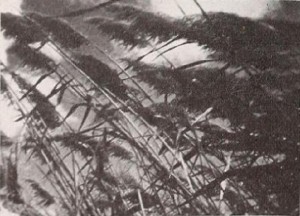
"Herman Bartei has, in Pathetique, made another contribution in the special field which he shares with Walt Disney and Leopold Stokowski — that of setting music to film. In this process, the music is the absolute, to which the footage must conform. While Disney achieves his conformity with drawings, Bartei uses actual cinematography of natural scenes. Mr. Bartel's absolute in this instance is the first movement of Tschaikowsky's Sixth — or Pathetique — Symphony, which is played from start to finish on double turntables, while the film sets forth what its maker feels is an interpretation in motion pictures of the music. The footage consists of autumn scenes, whose subject matter and tempo are varied to agree with the musical expression. The success or failure of this type of effort must depend upon the universality of the conviction of unity between musical and scenic episodes. Mr. Bartei reaches several high spots, notably one in which swirling crows against an angry sky are in very real harmony with the musical statement. Other scenes of autumn mist are very apposite to Tschaikowsky's phrases. The synthesis as a whole is both convincing and emotionally exciting." Movie Makers, Dec. 1943, 474.
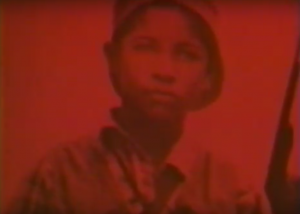
"En Patria Libre, Sergio García documentó los primeros logros de la revolución sandinista en Nicaragua. [...] Se trataba de un documental convencional, con una voz off (leída por Felio Eliel) sobre un momento de frescura y esperanza por el triunfo del Frente Sandinista de Liberación Nacional. El arranque del documental con una serie de imágenes de Sandino en alto contraste que culminan en la foto de un adolescente guerrillero (mientras que en la banda sonora se escucha a Pablo Milanés cantar "Los caminos") preludian el tono que se desarrollará sobre el caso de la revolución sandinista" (Vázquez Mantecón, 2012.)
"In Patria Libre [Free Country], Sergio García documented the first achievements of the Sandinista Revolution in Nicaragua. It was a conventional documentary, with an off voice (read by Felio Eliel) about a moment of freshness and hope because of the triumph of the Sandinista National Liberation Front. The documentary begins with a series of highly contrasted images of Sandino that end with the picture of a guerrilla teenager (while the soundtrack plays "Los caminos" [The roads] by Pablo Milanés), which is a prelude to the tone that will be used to describe the Sandinista Revolution" (Vázquez Mantecón, 2012).
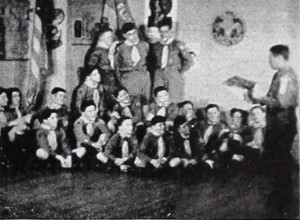
"With its first, full dress training film for Scoutmasters, the Visual Education Service of the Boy Scouts of America embarks, in The Patrol Method, on a new pedagogical path. Instead of presenting the perfect method for emulation, the movie records what happens when Scoutmasters and patrol leaders, with more enthusiasm than shrewdness, do things in ways that invite difficulty. The wiser course is pointed out tactfully, but indirectly, in the film. Here is an unusual employment of the movie medium, but the United States Army and Navy found that it worked in war training. The film is intended for use with a printed outline, and verbal conferences will follow its showings. Directly designed to accomplish a specific teaching task, The Patrol Method does it admirably." Movie Makers, Dec. 1945, 498.
"In Pattern of Living we are told how life on this earth probably began. Most likely it started after the upheaval of the sun 5,000 million years ago. Algae and animacules were perhaps the first forms of life, to be followed by the vegetable, and later the worm which was the forerunner of insects as we know them today. Clorophyll, the narrator explains, is responsible for combining water with sunlight to produce sugar that gives energy. Much of the film was shot through a microscope and some animation is used" PSA Journal, Sept. 1965, 51.
"Patterns is an abstract type of filming endeavor and depicts lines in mass and motion as created by reflections in rippling bodies of water" PSA Journal, Sept. 1966, 35.
"A short amateur film that show “how to stop a war without trying anything much.” Footage of protesters and activists advocating against the war in Vietnam are intercut with altered images of war." via Chicago Film Archives
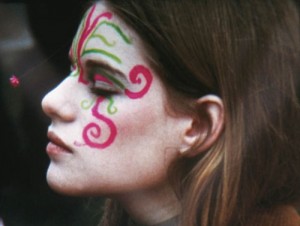
"Hippies, peace-niks, students, beautiful girls, civil righters, old ladies and more, protest the war. Who dares to say that they don't influence the mainstream? Beautiful color and exciting montage capture the feeling and motion of the march on the United Nations" via the Film-Makers' Cooperative.
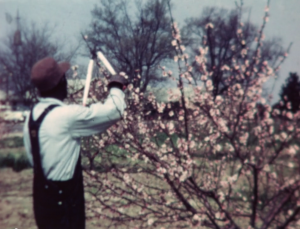
"The life cycle of the peach -- from peach blossom to peach pie" (Holmes, 2018).
"In Peasants, Konstantin Kostich, ACL, has produced a sympathetic and withal entertaining picture of the people of village and farm land in Czechoslovakia and Roumania. Expert photography, an understanding choice of camera angle and workmanlike sequences mark this interesting film study and serve as a vehicle for its outstanding quality — a sincere and attractive presentation of the people as they are, not as they might be made to appear for the sake of motion picture cleverness. Mr. Kostich needs rely only on his own skill and can afford to neglect making a point of what, in dress or custom, might appear to be a strange peculiarity to another people. Unlike many professional travel photographers, he can avoid these obvious aids to sustain interest and can present his peasants on the friendly basis of real understanding. This does not mean that he does not tell a real story; it simply means that he tells it fairly and sincerely and, hence, beautifully." Movie Makers, Dec. 1934, 534.
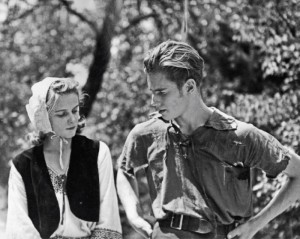
"Seldom has an amateur embarked upon so formidable a production as did David Bradley when he and some friends decided to film Ibsen's Peer Gynt, using Grieg's music for background. This mystic drama is considered so difficult that it has been performed only twice in the American theatre; yet the task held no terror for this group. Fashioning their own costumes and finding suitable locations in suburban Chicago, Mr. Bradley's intrepid band has done an amazingly good job. It would be easy to visualize the result had the production been in less capable hands than those of Mr. Bradley, and it is to his great credit that such quaint characters as the Button Moulder and the many trolls and woodland sprites do not appear ludicrous. The chief fault in this tremendous undertaking is that Ibsen's gigantic play has been transliterated to the screen rather than translated. That is, Mr. Bradley, by his own admission, modeled his scenario as closely as possible on a work written expressly for the theatre. Had he taken more liberties with the dramatic form in favor of a more peculiarly cinematic treatment — as exemplified so strikingly in the fine Hall of the Mountain King sequence — there would have been no structural weaknesses in his film. With this fundamental concept firmly in mind, Mr. Bradley, recently turned twenty one, should scale the heights in his future productions." Movie Makers, Dec. 1941, 566.
Total Pages: 299